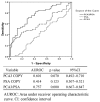Diagnostic significance of urinary long non-coding PCA3 RNA in prostate cancer
- PMID: 28938580
- PMCID: PMC5601676
- DOI: 10.18632/oncotarget.17272
Diagnostic significance of urinary long non-coding PCA3 RNA in prostate cancer
Abstract
Prostate cancer antigen 3(PCA3) is a long non-coding RNA, which was found increased expression in CaP patients than healthy individual. In this study, the individual nucleic acid of PCA3 and PSA was recombinant expressed as a reference reagent, and a quantitative RT-PCR with TaqMan assay was developed to examine the copies of PCA3 and PSA gene in urine. The results showed that the area under the receiver operating characteristic curve (AUROC) was 0.717, 0.444 and 0.916 for the number of PCA3 copy, PSA copy and for the score of PCA3/PSA RNA, respectively. Additionally, the AUROC for serum tPSA was 0.674 with a low specificity of 12.07%. Finally, the algorithm of PCA3 RNA versus PSA RNA was evaluated and corroborated as CaP biomarker by conducting a multicentric clinical trial. This study not only validated the developed technique of qRT-PCR with TaqMan assay for examination of urinary PCA3 and PSA RNA, it also demonstrated that the score of the PCA/PSA RNA was a reliable signature for CaP diagnosis.
Keywords: cell-free; diagnostic signature; prostate cancer; prostate cancer antigen 3; prostate-specific antigen.
Conflict of interest statement
CONFLICTS OF INTEREST Fluorescence polymerase chain reaction (PCR) Detection kit for the analysis of human PCA3 gene expression in urine PCA3 was patented to Dr. Tao Wang, Xiangyun Qu, linfu He and Peng Gao in China. The other authors declare no conflict of interest.
Figures





Similar articles
-
Clinical Significance of Peripheral Blood PCA3 Gene Expression in Early Diagnosis of Prostate Cancer.Transl Oncol. 2018 Jun;11(3):628-632. doi: 10.1016/j.tranon.2018.02.019. Epub 2018 Mar 22. Transl Oncol. 2018. PMID: 29574327 Free PMC article.
-
PCA3 sensitivity and specificity for prostate cancer detection in patients with abnormal PSA and/or suspicious digital rectal examination. First Latin American experience.Urol Oncol. 2013 Nov;31(8):1522-6. doi: 10.1016/j.urolonc.2012.05.002. Epub 2012 Jun 9. Urol Oncol. 2013. PMID: 22687565
-
A comparative performance analysis of total prostate-specific antigen, percentage free prostate-specific antigen, prostate-specific antigen velocity and urinary prostate cancer gene 3 in the first, second and third repeat prostate biopsy.BJU Int. 2012 Jun;109(11):1627-35. doi: 10.1111/j.1464-410X.2011.10584.x. Epub 2011 Sep 21. BJU Int. 2012. PMID: 21939492 Clinical Trial.
-
Urinary Prostate Cancer Antigen 3 as a Tumour Marker: Biochemical and Clinical Aspects.Adv Exp Med Biol. 2015;867:277-89. doi: 10.1007/978-94-017-7215-0_17. Adv Exp Med Biol. 2015. PMID: 26530372 Review.
-
PCA3 and TMPRSS2-ERG gene fusions as diagnostic biomarkers for prostate cancer.Chin J Cancer Res. 2016 Feb;28(1):65-71. doi: 10.3978/j.issn.1000-9604.2016.01.05. Chin J Cancer Res. 2016. PMID: 27041928 Free PMC article. Review.
Cited by
-
A Rich Array of Prostate Cancer Molecular Biomarkers: Opportunities and Challenges.Int J Mol Sci. 2019 Apr 12;20(8):1813. doi: 10.3390/ijms20081813. Int J Mol Sci. 2019. PMID: 31013716 Free PMC article. Review.
-
Clinical Significance of Peripheral Blood PCA3 Gene Expression in Early Diagnosis of Prostate Cancer.Transl Oncol. 2018 Jun;11(3):628-632. doi: 10.1016/j.tranon.2018.02.019. Epub 2018 Mar 22. Transl Oncol. 2018. PMID: 29574327 Free PMC article.
-
Transforming Diagnosis and Therapeutics Using Cancer Genomics.Cancer Treat Res. 2023;185:15-47. doi: 10.1007/978-3-031-27156-4_2. Cancer Treat Res. 2023. PMID: 37306902
-
Advancements in Biomarkers of Prostate Cancer: A Review.Technol Cancer Res Treat. 2024 Jan-Dec;23:15330338241290029. doi: 10.1177/15330338241290029. Technol Cancer Res Treat. 2024. PMID: 39440372 Free PMC article. Review.
-
Long non-coding RNA in prostate cancer.Am J Clin Exp Urol. 2022 Jun 15;10(3):170-179. eCollection 2022. Am J Clin Exp Urol. 2022. PMID: 35874287 Free PMC article. Review.
References
-
- Cleutjens KB, van Eekelen CC, van der Korput HA, Brinkmann AO, Trapman J. Two androgen response regions cooperate in steroid hormone regulated activity of the prostate-specific antigen promoter. J Biol Chem. 1996;271:6379–6388. - PubMed
-
- Lindzey J, Kumar MV, Grossman M, Young C, Tindall DJ. Molecular mechanisms of androgen action. Vitam Horm. 1994;49:383–432. - PubMed
-
- Culig Z, Santer FR. Androgen receptor signaling in prostate cancer. Cancer Metastasis Rev. 2014;33:413–427. - PubMed
-
- Buzzoni C, Auvinen A, Roobol MJ, Carlsson S, Moss SM, Puliti D, de Koning HJ, Bangma CH, Denis LJ, Kwiatkowski M, Lujan M, Nelen V, Paez A, et al. Metastatic prostate cancer incidence and prostate-specific antigen testing: new insights from the European randomized study of screening for prostate cancer. Eur Urol. 2015;68:885–890. - PMC - PubMed
-
- Salman JW, Schoots IG, Carlsson SV, Jenster G, Roobol MJ. Prostate specific antigen as a tumor marker in prostate cancer: biochemical and clinical aspects. Adv Exp Med Biol. 2015;867:93–114. - PubMed
LinkOut - more resources
Full Text Sources
Other Literature Sources
Research Materials
Miscellaneous

